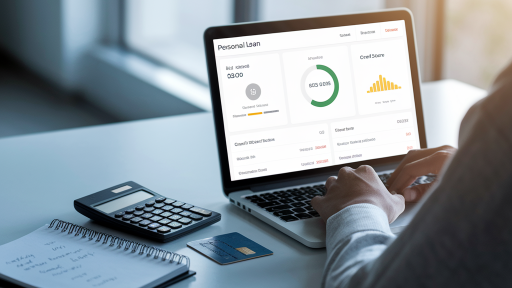Thinking about a personal loan can feel like a big step. Whether you’re aiming to consolidate high-interest debt, finance a home renovation, or cover an unexpected expense, a personal loan offers a structured way to get the funds you need. It’s a versatile financial tool that can provide a real solution when used responsibly.
But before you start filling out applications, it’s crucial to pause and understand what lenders are looking for. Being prepared not only demystifies the process but also significantly boosts your chances of getting approved with favorable terms. This guide will walk you through the essential requirements, helping you get your financial ducks in a row for a successful application.
What Lenders Scrutinize: The Core Pillars of Your Application
When you apply for a personal loan, lenders are essentially assessing one thing: risk. They want to be confident that you can and will repay the loan on time. To do this, they evaluate several key areas of your financial profile. While specifics can vary from one institution to another, nearly all lenders will focus on a few core pillars: your credit history, your income and ability to repay, and your existing debt load. Understanding each of these components is the first step toward building a strong application.
Your Credit Score: The Three-Digit Number That Speaks Volumes
Your credit score is often the first thing a lender looks at, and for good reason. It’s a numerical summary of your credit history and serves as a quick snapshot of your reliability as a borrower. A higher score indicates a lower risk to the lender, which can translate into better loan offers.
Why Your Credit Score is a Key Requirement
Lenders use your credit score to predict the likelihood that you will pay back your loan as agreed. This score is calculated based on information in your credit reports, including your payment history, the amount of debt you carry, the length of your credit history, the types of credit you use, and any recent credit inquiries. A history of on-time payments and responsible credit management will result in a higher score, signaling to lenders that you are a dependable borrower.
What is a “Good” Credit Score for a Personal Loan?
While there’s no single magic number, credit scores generally fall into specific ranges. Having a score in the “Good” to “Excellent” range will give you the best chance of approval and unlock the most competitive interest rates. If your score is in the “Fair” or “Poor” range, you may still qualify, but likely with a higher interest rate or you might need to consider a secured loan.
| Credit Score Range (FICO) | Rating | Typical Lender Perception |
|---|---|---|
| 800 – 850 | Exceptional | Lowest risk. Access to the best interest rates and terms. |
| 740 – 799 | Very Good | Low risk. High likelihood of approval with very competitive rates. |
| 670 – 739 | Good | Considered a reliable borrower. Good approval odds and standard rates. |
| 580 – 669 | Fair | Subprime borrower. May qualify but with higher interest rates and fees. |
| 300 – 579 | Poor | High risk. Approval is difficult; may require a co-signer or secured loan. |
How to Check and Improve Your Credit Score
Before applying, you should always know where you stand. You are entitled to a free credit report from each of the three major credit bureaus (Equifax, Experian, and TransUnion) once a year. Reviewing your reports allows you to check for errors and see what lenders see.
If your score isn’t where you want it to be, you can take steps to improve it:
- Pay all your bills on time: Payment history is the most significant factor in your credit score.
- Pay down credit card balances: High credit utilization (the amount of credit you’re using compared to your limit) can lower your score.
- Avoid opening new accounts: Each application can result in a hard inquiry, which can temporarily dip your score.
- Dispute any inaccuracies: If you find errors on your report, dispute them with the credit bureau immediately.
Proof of Income and Employment Stability
A great credit score is only half the battle. Lenders also need to be certain you have the financial means to make your monthly payments. This is where your income and employment history come into play. They want to see a stable and sufficient source of income to cover your existing obligations plus the new loan payment.
Why Steady Income is Non-Negotiable
Consistent income demonstrates your ability to repay the loan. Lenders look for stability, so someone who has been at the same job for several years may be viewed more favorably than someone who has frequently changed jobs. The amount of income is also critical, as it directly impacts how much you can afford to borrow.
Common Income Documentation Required
Be prepared to provide concrete proof of your earnings. The exact documents will depend on your employment status, but you should have them ready before you apply. Common requirements include:
- For Salaried Employees:
- Recent pay stubs (usually from the last 30 days)
- W-2 forms from the past one or two years
- Recent bank statements showing direct deposits
- For Self-Employed Individuals or Freelancers:
- Tax returns from the past two years (Form 1040 with all schedules)
- 1099-MISC or 1099-NEC forms
- Bank statements (business and personal)
- Profit and loss statements
Decoding Your Debt-to-Income (DTI) Ratio
Your Debt-to-Income (DTI) ratio is another critical metric lenders use to assess your financial health. It compares your total monthly debt payments to your gross monthly income, providing a clear picture of your financial obligations relative to your earnings.
What is DTI and How is it Calculated?
The calculation is straightforward. You add up all your monthly debt payments—such as rent or mortgage, car loans, student loans, credit card minimum payments, and other loan payments—and divide that total by your gross monthly income (your income before taxes). The result is then multiplied by 100 to get a percentage.
Example: If your total monthly debts are $1,800 and your gross monthly income is $5,000, your DTI is ($1,800 / $5,000) * 100 = 36%.
What DTI Ratio Do Lenders Prefer?
Lenders want to see a low DTI, as it suggests you have enough income left over to comfortably handle a new loan payment. While the ideal DTI can vary, here’s a general guide:
- 36% or less: Generally considered excellent. You are in a strong position to manage more debt.
- 37% to 43%: Often manageable and acceptable to many lenders, but you may not get the best rates.
- 44% to 50%: Considered a higher risk. Fewer lenders will approve an application in this range.
- Above 50%: High risk. It is very difficult to get approved for a new loan with a DTI this high.
If your DTI is high, consider paying down some of your existing debt before you apply for a new loan. To learn more about how this ratio impacts your borrowing power, you can find detailed information on what a debt-to-income ratio is and why it matters from major credit bureaus.
Essential Documents: Your Personal Loan Application Checklist
Being organized is key to a smooth application process. Gathering your documents ahead of time will prevent delays and show lenders that you are a serious and prepared applicant. Use this checklist to ensure you have everything you need.
| Document Category | Specific Items | Why It’s Needed |
|---|---|---|
| Proof of Identity |
|
To verify you are who you say you are and prevent fraud. |
| Proof of Address |
|
To confirm your current residence. |
| Proof of Income |
|
To prove you have a stable and sufficient income to repay the loan. |
| Banking Information |
|
For depositing the loan funds upon approval and for setting up automatic payments. |
Other Factors That Can Influence Your Application
While credit, income, and DTI are the heavy hitters, a few other elements can sway a lender’s decision or affect the terms you’re offered.
Collateral (for Secured Loans)
Most personal loans are unsecured, meaning they aren’t backed by any asset. However, if you have a lower credit score, a lender might offer you a secured loan. This requires you to put up collateral, such as a car, a savings account, or another valuable asset. Pledging collateral reduces the lender’s risk, which can make it easier to get approved and may even result in a lower interest rate. The downside is that if you default on the loan, the lender can seize the collateral.
Co-Signers and Co-Applicants
If your application isn’t strong enough on its own, adding a co-signer or co-applicant could be the solution. A co-signer is someone with a strong credit and income profile who agrees to be legally responsible for the debt if you fail to pay. This provides an extra layer of security for the lender. A co-applicant applies for the loan with you, and their income and credit are considered alongside yours, which can help you qualify for a larger loan amount or better terms.
The Application Process: A Step-by-Step Overview
Once you’ve done your homework and gathered your documents, the application process itself is usually quite direct. Here’s what you can typically expect:
- Pre-qualification: Many lenders offer a pre-qualification process. You provide some basic financial information, and the lender performs a “soft” credit check, which doesn’t affect your credit score. This gives you an idea of the loan amount and interest rate you might qualify for.
- Gathering and Submitting Documents: After choosing a lender, you’ll complete the formal application and submit the required documentation we’ve discussed.
- Formal Application and Hard Inquiry: When you formally apply, the lender will perform a “hard” credit inquiry. This will appear on your credit report and can cause a small, temporary dip in your score. This is why it’s wise to do all your loan shopping within a short period (e.g., 14-30 days) so the inquiries are treated as a single event.
- Verification and Underwriting: The lender’s underwriting team will review your entire application, verify your information, and make a final decision. They may contact you if they need any additional clarification.
- Approval and Funding: If you’re approved, you’ll receive a loan agreement to sign. Once you sign, the funds are typically deposited directly into your bank account, sometimes as quickly as the next business day. For more information on navigating this part of the journey, resources from financial advisors can offer valuable insight on how to get a personal loan.
Comparing Lenders: Not All Requirements Are Created Equal
It’s important to remember that requirements can differ significantly between types of lenders. Shopping around is essential to finding the best fit for your financial situation.
- Traditional Banks: Often have stricter credit and income requirements. They are a good option for borrowers with excellent credit who may already have a relationship with the bank.
- Credit Unions: As non-profit, member-owned institutions, they may offer more flexible requirements and lower interest rates than banks. They often prioritize the member’s overall financial picture over just a credit score.
- Online Lenders: These fintech companies often have a streamlined digital application process and faster funding times. They may be more lenient with credit score requirements but can sometimes have higher interest rates to compensate for the added risk.
Taking the time to prepare before you apply for a personal loan is the single most effective thing you can do to ensure a positive outcome. By understanding your credit profile, organizing your financial documents, and knowing what lenders value, you transform from a hopeful applicant into a confident borrower. This preparation not only increases your chances of approval but also empowers you to secure the best possible terms for your financial goals. For a comprehensive overview, the U.S. government provides reliable resources for consumers on understanding personal loan requirements before you apply.





